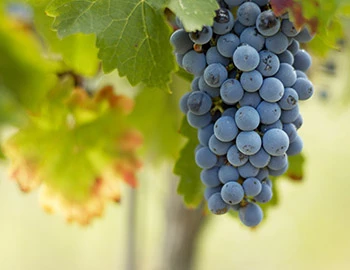
Château Sansonnet 2019
AC Saint-Emilion Grand cru classé, 1500 ml

| Grape variety: | Merlot, Cabernet Franc |
| Producer: | Château Sansonnet |
| Origin: | France / Bordeaux / St-Emilion |
| Other bottle sizes: | |
| Other vintages: |
Description
Generous and full-bodied, delighting the connoisseur, this modern Bordeaux cannot conceal its origins. The distinctly noticeable, but fi ne and pleasant tannins will give it a long life. Dried plums, blackcurrants, blackberries, liquorice and tapenade, dark chocolate and cedar wood are its predominant flavours.
Attributes
| Origin: | France / Bordeaux / St-Emilion |
| Grape variety: | Merlot, Cabernet Franc |
| Ripening potential: | 5 to 15 years |
| Drinking temperature: | 16 to 18 °C |
| Food Pairing: | Beef Stroganoff, Bistecca fiorentina, T-Bone steak, Wild boar entrecôte with Spätzli, Châteaubriand, Filet Wellington, Latin American dishes |
| Volume: | 15.0 % |
| Note: | Contains sulphites |
Cabernet Franc
Forefather of the Bordeaux varieties
The Cabernet Franc is one of the oldest varieties of Bordelais and a parent of three other red grapes in the Bordeaux assortment: Cabernet Sauvignon, Merlot and Carmenère. It is distinguished by its complex, flavourful bouquet of raspberry, graphite, violet, liquorice and white pepper. In addition, it presents round, crisp tannins which turn out less strongly than those of Cabernet Sauvignon. While the Cabernet Franc always appears as part of a blend in Bordeaux, it is pressed alone on the Loire. The most renowned appellations are Chinon and Bourgueil. Incidentally, the Cabernet originates not in Bordeaux but in the Spanish Basque Country. Cabernet owes its name to the Latin “carbon”, meaning black.

Merlot
Everybody’s darling
Merlot is the most charming member of the Bordeaux family. It shines with rich colour, fragrant fullness, velvety tannins and sweet, plummy fruit. It even makes itself easy for the vintner, as it matures without issue in cool years as well. This is in contrast to the stricter Cabernet Sauvignon, which it complements as a blending partner. Its good qualities have made the Merlot famous worldwide. At over 100,000 hectares, it is the most-planted grape in France. It also covers large areas in California, Italy, Australia and recently in Eastern Europe. The only catch is that pure Merlot varieties rarely turn out well. Its charm is often associated with a lack of substance. Only the best specimens improve with maturity. They then develop complex notes of leather and truffles. This succeeds in the top wines from the Bordeaux appellation of Pomerol and those from Ticino, among others.

St-Emilion
Saint-Emilion: unique Bordeaux idyll
A unique terroir, unique assemblage formula and a unique classification: Saint-Emilion occupies an exclusive position in Bordeaux. The wines are not as angular as in the Médoc, but not quite as opulent as in Pomerol. In terms of maturity, the wines fall between the early-maturing Pomerols and the Médoc growths, which require plenty of time. In assemblages, Merlot often plays the formative role. But Cabernet Franc also contributes greatly to the unique Saint-Emilion feel.

France
France – Philosophy in a bottle
According to French philosophy, wine should be an expression of the soil and climate. They use the word “terroir” to describe this. Terroir makes every wine different, and many especially good. French wine is regarded worldwide as an expression of cultural perfection. The French believe that humans are responsible for the quality of the berries, the vine variety for their character, and nature for the quantity. This philosophy can be expressed succinctly as: “the truth is the vineyard, not the man.”


